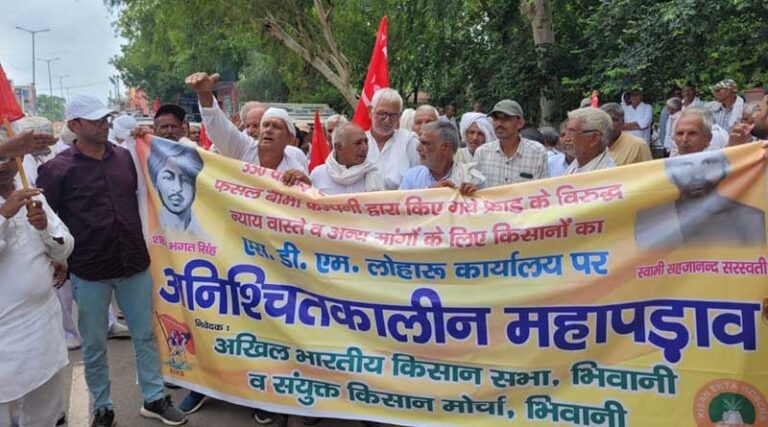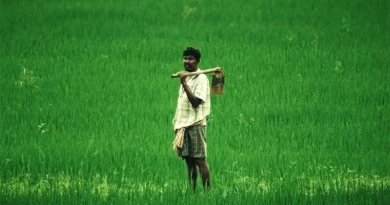
Why Is India’s Pradhan Mantri Fasal Bima Yojana Being Questioned?
By Jag Mohan Thaken
17 July 2025, New Delhi: Launched in the Kharif 2016 season, the Pradhan Mantri Fasal Bima Yojana (PMFBY) was introduced by the Government of India to provide a protective umbrella to farmers against natural calamities like droughts and floods, pest attacks, crop diseases, and post-harvest losses caused by local events such as hailstorms and landslides.
The Central Government has approved the continuation of PMFBY and the Restructured Weather-Based Crop Insurance Scheme (RWBCIS) until 2025–26, with a total outlay of ₹69,515.71 crore for the period 2021–22 to 2025–26.
Highlighting its key features, the government claims that PMFBY aims to settle claims within two months of harvest to ensure timely compensation, thereby helping farmers avoid falling into debt traps. Additionally, the scheme is said to integrate advanced technologies such as satellite imagery, drones, and mobile applications to enable accurate and transparent assessment of crop loss.
Reality on the Ground
Despite these assurances, the on-ground situation paints a contrasting picture. Farmers in the Bhiwani district of Haryana have been protesting for months over an alleged ₹350 crore insurance scam, which they attribute to misappropriation by insurance companies. On July 16, 2025, after an impassioned road march, the farmers began an indefinite sit-in at Loharu, the alleged epicentre of the scam.
If claims are as accurately and promptly settled as the government asserts, why are farmers repeatedly forced to agitate for compensation—often years after the loss? Why do they allege that their claims are being rejected on fabricated and misleading grounds?
Why are farmer delegations, armed with stacks of paperwork, compelled to personally plead their cases before Members of Parliament from Haryana and Rajasthan?
A farmer delegation leader explains, “To strengthen our movement, we meet MPs and inform them about our problems. We’re receiving assurances of full cooperation from them.”
RTI activist and farmer leader Dr. Balbir Singh alleges that following proper assessment of cotton crop damage caused by pink bollworm during Kharif 2023 in Bhiwani and Charkhi Dadri districts, the insurance company attempted to embezzle ₹350 crore in collusion with senior officials of the Agriculture Department. He claims the All India Kisan Sabha has exposed the scam, and the ongoing protest is against this injustice.
Not Just Haryana — Rajasthan Farmers Also Suffer
The problem is not limited to Haryana. Farmers in neighbouring Rajasthan have also alleged suffering due to implementation flaws and loopholes in the PMFBY.
Supporting the agitating farmers, Kumari Selja, MP from Sirsa and General Secretary of the All India Congress Committee, claimed in a press statement on July 12 that agricultural insurance schemes have become profit-making ventures for private companies rather than farmer-support initiatives. She stated that insurance companies are being favoured through illegal practices while farmers are left in distress.
Selja alleged that a ₹300 crore scam related to cotton claims for Kharif 2023 in Bhiwani and Charkhi Dadri took place due to collusion between officials of the Agriculture Department and the concerned insurance company. So far, no action has been taken against the culprits, nor has compensation reached the affected farmers.
She called for immediate and strict action against the officials involved in insurance-related scams and demanded urgent intervention from both central and state governments.
Is PMFBY a Flawed Scheme?
Calling the current structure of PMFBY “defective and arbitrary,” Selja criticized the village unit system of damage assessment, where the entire village is treated as a single unit. As a result, if a farmer’s field is damaged but the rest of the village isn’t declared as affected, no compensation is paid. She labelled this system “anti-farmer” and urged immediate reforms.
“In the era of climate change, events like floods, excessive rainfall, and hailstorms are becoming frequent. If a farmer’s crop is destroyed, compensation must be paid immediately so that they can prepare for the next sowing. But under the current system, delays of 2–3 years are common, pushing farmers further into debt,” she said.
According to her, governments are eager to collect premiums but leave farmers at the mercy of insurance companies when it comes to claim settlements.
A Profit-Making Tool for Insurance Companies?
Former Congress President and Leader of Opposition in Lok Sabha, Rahul Gandhi, has also criticised the PMFBY. While addressing a rally in Odisha on July 11, 2025, he alleged:
“The PM Fasal Bima Yojana has only one aim — to take money from poor farmers and the government and funnel it into the pockets of 3–4 billionaires. They don’t care what happens to farmers during disasters.”
A press release by the Congress Party, dated July 11, quoted Gandhi further:
“Modi ji said the scheme would help farmers during disasters. But what really happened? The government collected money from poor farmers, from the states, and the Centre, and handed it to big corporates. When floods or hailstorms happen, farmers don’t get compensation. Thousands of crores have gone to these companies, but they never return it to farmers. This is a betrayal of the Constitution, which protects the poor and not the rich elite.”
Government’s Counterclaim: Scheme Is Successful
Contrary to the allegations, Union Agriculture Minister Narendra Singh Tomar, in a written reply in the Rajya Sabha on July 21, 2023, defended the PMFBY. He shared data on premium collection and claims settled under the scheme since inception:
PMFBY: Premiums, Claims, and Profit (2016–17 to 2022–23)
| Year | Premium Collected (₹ Crore) | Claims Paid (₹ Crore) | Profit (₹ Crore) |
|---|---|---|---|
| 2016–17 | 21,949.87 | 16,826.75 | 5,123.12 |
| 2017–18 | 24,468.36 | 22,087.97 | 2,380.39 |
| 2018–19 | 29,687.75 | 29,336.91 | 350.84 |
| 2019–20 | 32,362.06 | 27,372.97 | 4,989.09 |
| 2020–21 | 31,689.95 | 20,771.05 | 10,918.90 |
| 2021–22 | 29,598.43 | 17,881.43 | 11,717.00 |
| 2022–23 | 27,900.78 | 5,760.80 | 22,139.98 |
| Total | 1,97,657.20 | 1,40,037.88 | 57,619.32 |
Do the numbers support Rahul Gandhi’s criticism? The table clearly shows that while ₹1.97 lakh crore was collected as premiums, only ₹1.40 lakh crore was paid in claims — leaving a massive profit of ₹57,619.32 crore with the insurance companies over seven years.
Critical Questions Arise
If insurance companies are making such huge profits, why are claims frequently delayed or rejected? Why should already-struggling farmers bear penal interest on their Kisan Credit Card loans while waiting for rightful compensation?
Shouldn’t insurance companies bear the interest burden in such cases — especially when the government claims that PMFBY is designed to prevent farmers from falling into debt traps?
Moreover, when the Agriculture Insurance Company of India Ltd. (AIC) — a government enterprise — exists, why are private insurance companies being involved, especially when profit remains their main motive?
AIC was created as per the Union Finance Minister’s 2002–03 budget speech to better serve farmers and move towards an actuarial regime. If that is the intent, then shouldn’t the government revisit its partnership model under PMFBY?
Also Read: ICAR to Validate Biostimulants Before Sale, Says Union Agriculture Minister Shivraj Singh
📢 If You’re in Agriculture, Make Sure the Right People Hear Your Story.
From product launches to strategic announcements, Global Agriculture offers unmatched visibility across international agri-business markets. Connect with us at pr@global-agriculture.com to explore editorial and advertising opportunities that reach the right audience, worldwide.






